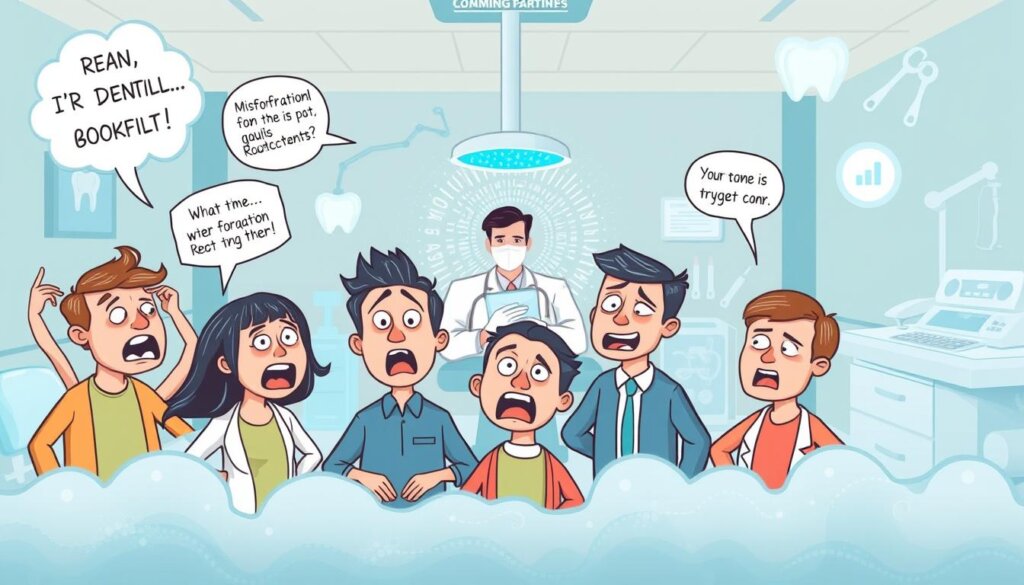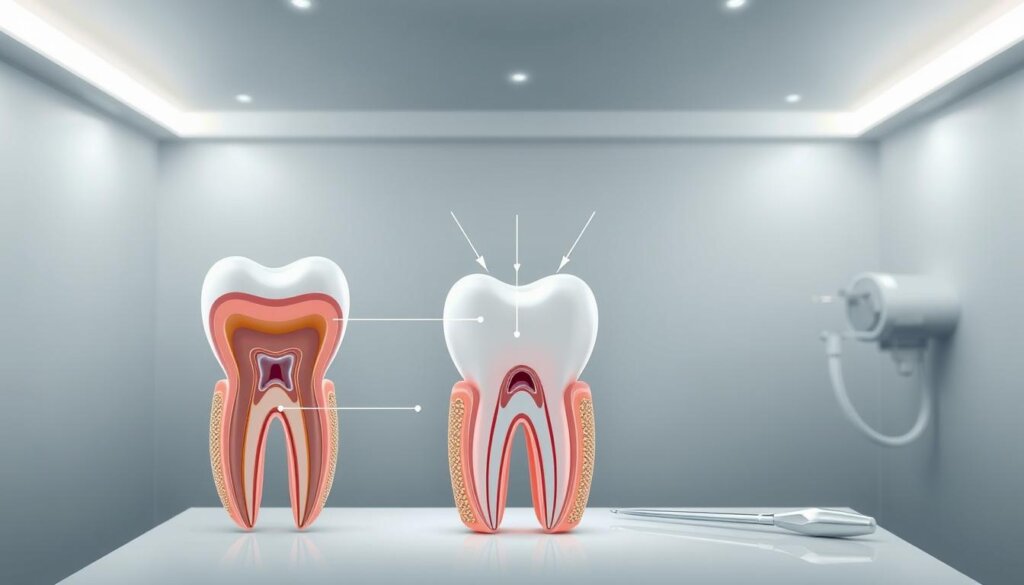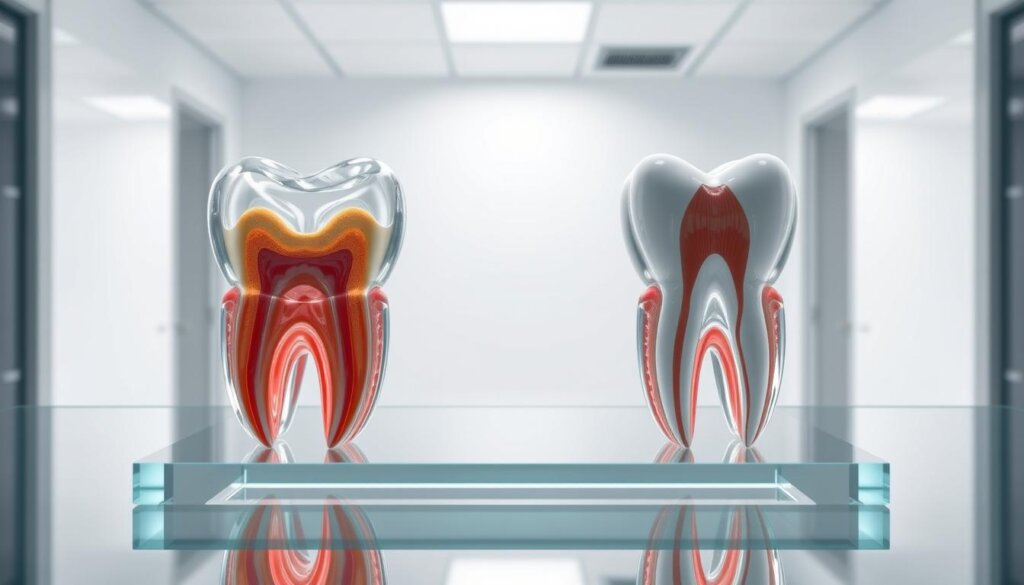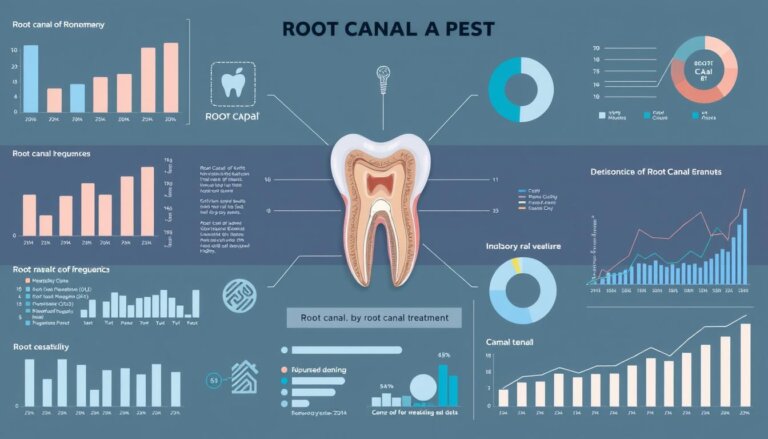How Do I Know If I Might Need a Root Canal?
Every year, over 15 million people in the U.S. get root canals. This shows how common deep tooth problems are. Many wonder, “How do I know if I might need a root canal?” This question comes up when teeth hurt, swell, or feel sensitive all the time.
Pain that doesn’t go away can mean the tooth is infected. If your tooth looks different or your gums are swollen, it might need a root canal. This is to keep your teeth healthy for a long time.
Key Takeaways
- Millions of root canal treatments show how common pulp infections are.
- Mild pain that gets worse can mean deeper tooth damage.
- Tooth discoloration and gum swelling can mean nerve problems.
- Sensitivity to hot or cold means the pulp is inflamed.
- Asking, “How do I know if I might need a root canal?” helps spot early signs.
Understanding Root Canals and Their Purpose
Root canals save teeth by removing inflamed pulp and stopping infections. This method keeps the tooth working and its outer part safe. Dentists use it to fix ongoing pain or damage, which are signs of root canal symptoms.
What is a Root Canal?
A root canal goes inside a tooth to the area with nerves and blood vessels. It removes infected pulp to stop bacteria from spreading. This saves the tooth’s structure, relieves pain, and prevents more problems.
Why Are Root Canals Necessary?
They’re needed when a tooth’s soft tissue gets too damaged or inflamed. Dentists do this to stop abscesses and tooth loss. With modern tools and anesthesia, it’s a safe way to keep teeth healthy and avoid risks.
Common Signs Indicating the Need for a Root Canal
Spotting early signs is key to keeping your teeth healthy. Dentists watch for chronic pain, long-lasting sensitivity to hot or cold, and teeth that darken. These signs often mean there’s hidden damage inside the tooth.
Persistent Toothache
A toothache that won’t go away can mean the pulp is inflamed. Pain that throbs or feels sharp can get worse if the infection grows. It’s important to get help quickly, as the pain won’t go away on its own.
Sensitivity to Hot and Cold
Feeling pain when you drink something hot or cold can be a warning sign. If the pain lasts more than a few seconds, it might mean your nerves are involved.
Discoloration of the Tooth
Teeth that darken or look dull gray might have a dying nerve. This means the inside of the tooth is not healthy. If not treated, it could get worse.
| Indicator | Possible Implication |
|---|---|
| Unrelenting Ache | Potential Pulp Inflammation |
| Temperature Discomfort | Nerve Sensitivity |
| Tooth Darkening | Dying or Severely Damaged Pulp |
Physical Symptoms to be Aware Of
People might see changes in their gums that show deeper issues. Swelling around a tooth could mean inflammation that needs fast action. Any unusual sign, along with ongoing tooth pain, should be checked out.
Swelling of the Gums
Gum tissue might swell or become puffy near a tooth. This discomfort is a sign of possible infection. Catching it early can prevent more serious problems.
Tenderness Around the Affected Tooth
Even a light touch can cause pain. This pain means the pulp or ligaments are stressed. Pain when biting down is a clear sign to see a dentist.
Presence of a Pimple on the Gums
A small bump like a pimple might appear near the infected area. This abscess is the body’s way to get rid of infection. Quick treatment can stop bigger issues and keep your mouth healthy.
Behavioral Symptoms That May Indicate a Problem
Could small changes in how we eat or brush our teeth hint at bigger dental issues? Changes in our daily habits might show signs of root canal infection symptoms. If we avoid brushing or eating certain foods, it can lead to more decay and pain.
Difficulty Chewing or Biting
Feeling pain when we bite down is a clear sign of a problem tooth. This pain makes us chew on the other side, leaving the sore tooth untouched and at risk.
Avoidance of Certain Foods
Hard foods like crunchy snacks put extra pressure on teeth in pain. To avoid pain, we might:
- Stick to soft foods or liquids
- Miss meals that need a lot of chewing
This behavior can hide root canal infection symptoms that get worse over time.
Changes in Oral Hygiene Habits
Some people avoid brushing or flossing near a sore tooth to avoid pain. Not cleaning properly lets bacteria grow, making the problem worse. If you notice these changes, getting a dental check-up is important.
Localized Symptoms to Consider
Some warning signs show up in the mouth, hinting at tooth problems inside. Changes in how things smell or taste can mean there’s an infection. This calls for a closer look by doctors.
Bad Breath
Bad breath that won’t go away can mean bacteria buildup. If you brush well but can’t shake off bad breath, it might be a sign of a bigger issue. This could mean there’s dead tissue inside the tooth.
Foul Taste in the Mouth
A sour or metallic taste can mean your tooth is decaying. If food tastes off because of your tooth, it’s a sign of trouble. Catching these signs early can help keep your mouth healthy.
| Symptom | Likely Cause | Recommended Action |
|---|---|---|
| Consistent Bad Breath | Bacterial Infection | Seek Dental Evaluation |
| Unpleasant Mouth Taste | Tooth Decay | Request Pulp Assessment |
When to See a Dentist
If you’re feeling unexplained tooth pain, it’s time to see a dentist. They can spot and fix small problems before they get big. Pain or changes in your teeth could mean something serious is going on.
Importance of Timely Consultation
X-rays can show hidden problems, like infections in the tooth roots. Waiting too long can lead to bigger issues. A quick check-up can save your teeth from serious damage.
Recommended Dental Exam Tips
A detailed dental exam can catch small issues before they cause pain. Here are some tips for a better visit:
- Write down any symptoms or questions you have.
- Ask about scans that can find hidden problems.
- Learn how to prevent new issues from happening.
Being aware of dental problems and acting early can keep your teeth healthy for a long time. Regular visits and talking openly with your dentist are key to a healthy smile.
Diagnostic Tools Used by Dentists
Dentists use special methods to find problems that might lead to a cracked tooth root canal. They look for hidden decay and check the nerve’s health. This helps them make the right treatment plan.
X-Rays
X-rays show cracks and decay under the enamel. They can spot cavities and bacteria in the pulp chamber. This early detection helps fix problems before they get worse.
Pulp Vitality Tests
Pulp vitality tests check how the tooth’s nerve responds. A healthy nerve reacts to temperature changes or electric tests. If the nerve doesn’t react much, a cracked tooth root canal might be needed.
Risk Factors for Needing a Root Canal
Some teeth seem strong until they need a root canal. Injuries and hidden decay can damage the inside of the tooth. This creates a path for infection. Knowing these risk factors helps prevent unwanted problems.
Dental Trauma
Physical impacts from falls or sports accidents can hurt the pulp without warning. The American Association of Endodontists says trauma can cause nerve damage. This damage often leads to the need for a root canal.
Deep Cavities
Decay can reach the inner layers of a tooth, irritating the nerve. Bacteria grow, weakening the tooth. Sharp or lingering pain often means the pulp is involved.
Previous Dental Work
Repeated fillings or crowns can weaken a tooth over time. Decay under old restorations may not be seen. This can lead to inflammation and severe pain, needing a root canal.
Treatment Options Beyond Root Canals
Modern dentistry aims to save natural teeth. Sometimes, we need to explore other options. Patients often face a tough choice: root canal vs extraction. The goal is to protect long-term oral health, considering each option’s pros and cons.
Alternatives to Root Canals
If a tooth can’t be saved, more extensive procedures are considered. Here are a few:
- Extraction for advanced decay
- Bridge or implant to replace a lost tooth
- Portal for future restorative therapy when feasible
Palliative Care
Some treatments aim to ease pain. Options include:
- Short-term medication for pain relief
- Antibiotics to combat infection
- Warm saline rinses for mild soothing
| Option | Description | Potential Outcome |
|---|---|---|
| Extraction | Removing the tooth entirely | Prevents further decay |
| Medication | Temporary solutions like painkillers | Short-lived comfort |
| Restorative Work | Bridge, crown, or implant | Long-term stability |
What to Expect During a Root Canal Procedure
Dentists use modern tools and methods to make root canals comfortable. They use advanced cleaning systems and precise imaging. This helps them work efficiently and thoroughly.
People often ask how long they’ll be in the dentist’s chair. Experts say new technologies, like the GentleWave system, make the process faster. They clean deep without needing to drill too much.
Pre-Procedure Preparation
The dentist sets up a clean area and isolates the tooth to avoid infection. They might suggest a mild sedative or local anesthetic. This helps you stay calm throughout the procedure.
Pain Management Options
Most people don’t feel much pain during or after the procedure. Here are some tips for a smooth recovery:
- Use over-the-counter pain relievers for any soreness.
- Apply cold compresses to reduce swelling.
- Avoid putting too much pressure on the treated tooth.
Aftercare Following a Root Canal
Patients often feel better after the treatment is done. Some might feel a bit sore, but this usually goes away quickly. Resting is important for healing, and you can usually get back to normal quickly.
Getting a permanent crown is also important for keeping the tooth strong.
Post-Procedure Symptoms
Some people might feel some sensitivity or swelling. Over-the-counter pain meds like ibuprofen or acetaminophen can help. It’s also good to watch for any signs that something might not be right.
Recommended Aftercare Practices
Here are some simple steps to help your tooth heal:
- Keep up with brushing and flossing
- Eat softer foods for a while
- Go to check-ups to see how you’re doing
- Get your tooth fixed with a crown soon
Following these steps can help your tooth last longer.
Going back for a check-up is important. It makes sure your tooth is okay and ready for a crown. This shows how important it is to take care of your teeth and get help when you need it.
Myths and Misconceptions About Root Canals
Many people think root canals are very painful. This idea comes from old methods that didn’t have today’s advanced tools. But, the truth is, root canals fix pain caused by infection deep in the tooth.

Nowadays, dentists use local anesthesia and sedation to keep patients calm. They aim to save the natural tooth and avoid more serious treatments.
Common Misunderstandings
Some people believe root canals are riskier than pulling the tooth. But, experts say saving the tooth is better for your long-term oral health. Also, many root canals are done in just one or two visits, not more.
Debunking Root Canal Fears
Today’s methods make the procedure almost painless. They use precise imaging and gentle tools. Studies show that the pain usually comes from the infected pulp, not the procedure itself. This helps relieve pressure, heal the tooth, and prevent future infections or surgeries.
Long-Term Considerations After a Root Canal
Keeping a treated tooth healthy is easier with regular care. Teeth that have had a root canal can last forever with the right care. Brushing, flossing, and dental visits are key. The American Dental Association also supports advanced restorations to protect the tooth.
Impact on Oral Health
Good oral health comes from regular cleanings and smart eating. Even with small bacteria, watching closely can stop infections from coming back. Some people need a crown to keep the tooth strong and prevent breaks.
This mix of dental care and patient education helps teeth last longer.
Future Dental Care Recommendations
Success over time depends on a few important steps. Keeping up with these habits helps keep the tooth safe and avoids new problems. Here are some tips:
- Make sure to get regular checkups to catch issues early
- Keep up with brushing and flossing to remove plaque
- Ask your dentist about getting a crown or more support
Working together, patients and dentists can keep a smile healthy and functional for years.
Conclusion: Knowing When to Seek Help
Root canal therapy can save a damaged tooth if you act fast. Dental experts say early action stops pain and keeps your teeth working well.
Encourage Early Intervention
Seeing a dentist quickly is important. Many dentists agree that fast treatment relieves pain and prevents infection. Signs like ongoing pain, gum swelling, or trouble with hot or cold drinks mean you might need a root canal.
Acting fast helps keep your teeth healthy and avoids bigger problems.
Summary of Key Symptoms to Remember
A toothache that won’t go away, sensitivity to hot or cold, and tooth discoloration could mean infection. Look out for gum swelling or a bump near the tooth. A quick dentist visit can save your tooth and keep your smile healthy.
Our goal is to improve health through research and education. Working together, we can keep teeth strong and smiles bright for everyone in the U.S.





